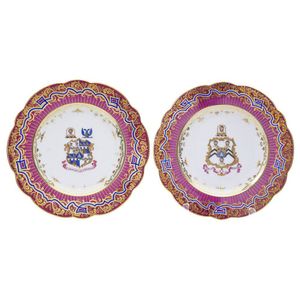Ridgway & Co. Armorial Plates, 19th Century
A pair of Ridgway & Co. Porcelain armorial plates, 19th century, circa 1840, the first plate decorated with elaborate gilt maroon borders, the centre painted with the Westhead coat of arms, with the motto 'Ora et Labora'. The reverse marked John Ridgway and co/ presented to J.P. Westhead Esq. The second plate with similar decoration however instead bearing the arms of Westhead quartering brown of Lea castle, representing the marriage of the parents of J. P. Westhead. The John scarce collection, 26 cm diameter, other notes: J.P.Westhead (1807-1877) was a prominent businessman and Weslyian Methodist. He was Director of the London and north Western Railways, M.P for Knaresborough and later York. He was the Son of Edward Westhead, who had married Ann brown, heiress to Lea castle. By 1862, the Ridgway factory was known as Brown-Westhead, Moore & Co. Several unique presentation services were made for him as gifts, bearing his coat of arms or crest. He married Betsy Chappell in 1828. He later inherited Lea castle from his father. The service was presented to Joshua on the 15th June 1847 at the Albion Hotel, Piccadilly Manchester. By the shareholders of the Manchester and Birmingham railway Company in recognition of his work as Chairman, before it was absorbed into the London and north Western railway. Approximately 1280 gms total weight together
You must be a subscriber, and be logged in to view price and dealer details.
Subscribe Now to view actual auction price for this item
When you subscribe, you have the option of setting the currency in which to display prices to $Au, $US, $NZ or Stg.
This item has been sold, and the description, image and price are for reference purposes only.
- Armorial / Armourial - Bearing a coat of arms. Coats of arms came into general use by feudal lords and knights in in the 12th century, and by the 13th century, arms had spread beyond their initial battlefield use to become a flag or emblem for families in the higher social classes of Europe. They were inherited from one generation to the next. When a family crest is used on individual items of silver or furniture it is an indicator of the aristocratic standing of the family represented.
Armorials were also used to decorate mass produced ceramic souvenir ware by such companies as Goss, Carlton & Shelley, and in these cases the coats of arms displayed were of boroughs and cities. - Circa - A Latin term meaning 'about', often used in the antique trade to give an approximate date for the piece, usually considered to be five years on either side of the circa year. Thus, circa 1900 means the piece was made about 1900, probably between 1895 and 1905. The expression is sometimes abbreviated to c.1900.
This item has been included into following indexes:
Visually similar items

Two Davenport 'Bamboo' pattern soup bowls, transfer printed, impressed mark, c.1830, 25 cm diameter.
Sold by
in
for
You can display prices in $Au, $US, $NZ or Stg.

Two Chinese Qing porcelain blue & white plates, 22.5 cm wide
Sold by
in
for
You can display prices in $Au, $US, $NZ or Stg.

Pair Copeland Spode grasshopper pattern bowls,
Sold by
in
for
You can display prices in $Au, $US, $NZ or Stg.

A pair of Davenport porcelain dishes, circa 1820-1830. Of oval formwith gilded scalloped rims, painted with floral and foliate subjects on a white field, 25.5 cm width, (2).
Sold by
in
for
You can display prices in $Au, $US, $NZ or Stg.
